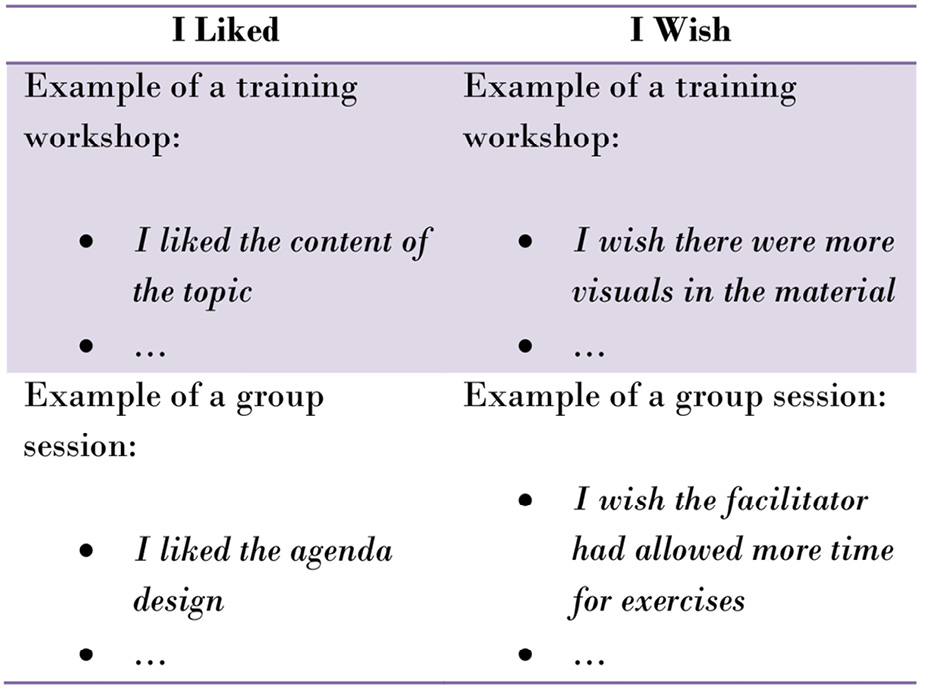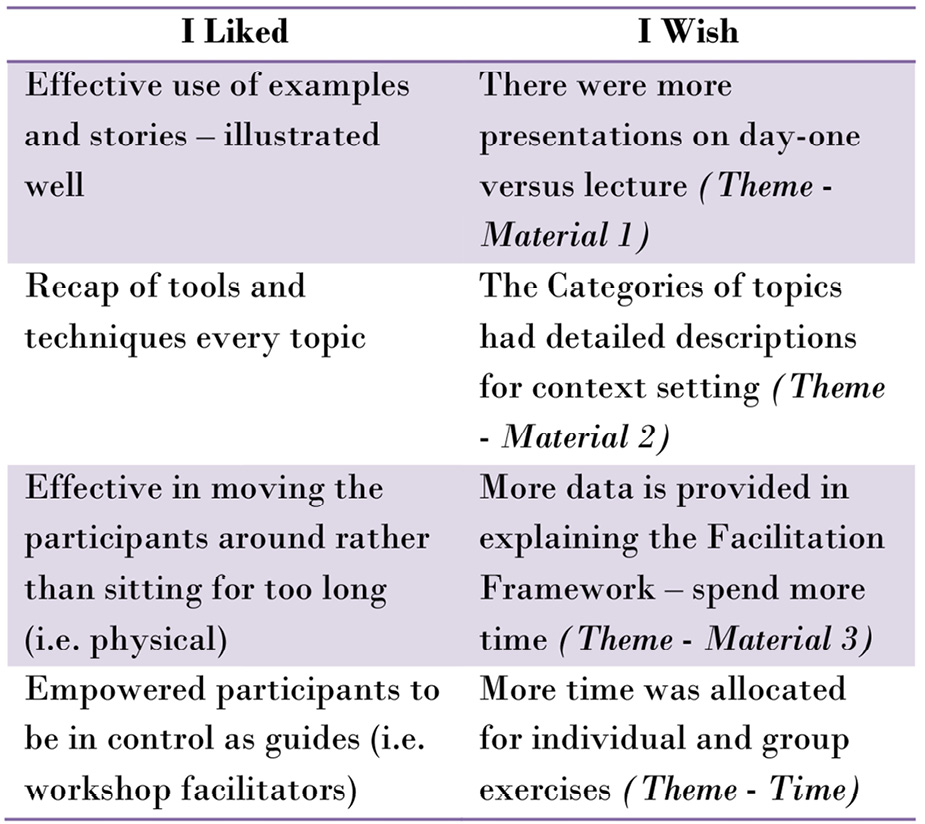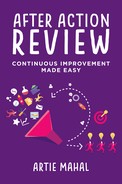CHAPTER 3
Informal After Action Review
The following template is worded in a manner that facts can be expressed honestly without offending anyone or pointing fingers at anyone. To apply this technique, the facilitator prompts the participants to address these key questions:
- What was planned?
- What actually occurred? (Remember to look at facts and not judgments.)
- What went well and why?
- What can be improved and how?
Approach
Identify and gain agreement on the topic for the After Action Review assessment. Describe what was planned, what actually occurred and then conduct a brainstorming exercise with the participants. Two approaches can be used for gathering information.
Individual reflection
Provide orientation to the participants in doing their individual assessment of what worked well and what can be done differently in the future. Furthermore, explain to them that after their individual assessment, a group brainstorming would be conducted to generate collective insights on the topic of lessons learned with an eye towards making recommendations for actions. The following template can be provided as pre-work or used in the real-time work session:

Group insights
Three formats are examples of what templates can be used by the facilitator. This depends on the facilitator’s preference, time allocated, and willingness of the participants.
Approach A:
- Frame the definition of an After Action Review for the participants and conduct the assessment.
- On a flip chart, create a template with two columns: I Liked and I Wish. These terms used as titles encourage a positive dialogue and avoid any blame-game.

- Prioritize the items “I Liked” and “I Wish” with the help of the participants. Facilitate a discussion to identify the solutions for improvement. Document their answers and rationale. In some cases, the participants can be assigned follow-up tasks to deliver those improvement solutions—right in that session. In other cases, a project manager may determine who will work on determining the solutions later.
- Identify next steps for how the learning will be documented and communicated to all relevant stakeholders and others who would benefit from these improvements.
- Thank the participants and close the AAR session.
- After the workshop, summarize the AAR result and communicate to relevant stakeholders.
Approach B:
This is an alternate template. It is similar to the one mentioned above, but with different wording. What Worked Well (WWW) and Even Better If (EBI). It is simply a matter of the facilitator’s preference.

Approach C:
This technique is used for gathering information using sticky notes. On a large wall-chart, make either of the templates shown in Approach A or Approach B.
- Describe the purpose of the AAR session. For the topic of focus, inform the participants that these questions are to be addressed in the format: I liked and I wish (as an example).
- Give the participants a stack of large size sticky-notes, and markers to write their responses. Instruct that only one idea be written (legibly!) per sticky note.
- The individuals then would write their responses and place them on the wall chart at random—in the pre-planned columns such as I Liked, I Wish, and We Learned.
- Cluster the sticky note responses into meaningful themes.

Concept diagram
This diagram on the facing page is an example of information gathering using a wall paper or flip chart.
- Have the participants create sticky notes with one idea per note.
- Cluster themes with like ideas and label these themes with appropriate titles.
- Prioritize for improvement. In this case each participant is given three or five paper dots; they vote by placing the dots on items they consider important. I refer to this as a “Dotocracy” as in democracy, a way to build consensus on items.

- Ask volunteers to step up and cluster the sticky-note responses into themes. Have the group discuss the gathered information for a common understanding and then prioritize themes that matter most. For each of these themes, identify lessons learned for future improvement.
- Assign responsibilities for improvement ideas (or defer for later follow-up).
- Identify next steps and close the AAR session.
- After the workshop, document the gathered information, summarize the AAR, and communicate this to participants and stakeholders.
Examples
Example 1
This is an AAR of a one-week personal cruise trip taken by my wife and me, from New York to Bermuda. The name of the cruise company is intentionally left out.

Summary:
While we enjoyed the cruise, we believe we did not get value for money paid for a better stateroom class. Among the “I Wish” categories, the most important for us next time would be to check on when the ship is refurbished / upgraded. We indicated this by using an asterisk in our list. If it has not been upgraded in the last five years or so, we will not go on it. In addition, we have learned that we can go on the comparison websites and check on the feedback by previous passengers about the quality of the food.
In this real example, which took for my wife and me no more than 15 minutes, we have collectively understood that age of the ship’s upgrading is very important to us. Moreover, we have decided to do more research about the cruise line and the venue by going on comparison websites where feedback of previous passengers would be of value.
Example 2
This is an example of an AAR of a two-day training in Facilitation Skills that I had conducted. As a trainer and facilitator, I have conducted many such classes. AAR was conducted immediately after the class had concluded. It took about 20 minutes to gather this very important information, which can be used for continuous improvement of the class including the material, venue, and the delivery.

At the conclusion of the training class, as an external contractor to the corporation, I had submitted my report to the director of Learning & Development of this organization. I then reviewed this feedback with the corporate training director. We both clustered the information into themes to determine actions for improvement. The themes are noted in the column under I Wish. The theme may be defined as a concept, entity, event, or thing that describes an issue, problem, or an opportunity. Note that in this chart, I use the word “Material” to refer to the content I created for this course.


Actions Taken by the Director:
The items under I Liked will be continued by the future class deliveries as before. The items under I Wish will be considered for improvement as prioritized below.


Communication:
The director then sent the actions and proposals to the appropriate stakeholders for implementation. The director also sent a note of thanks to the students for their AAR input and informed them of the actions being taken.
Conclusion:
Within a few minutes of the conclusion of the class, rich data was gathered as feedback. As a part of continuous improvement, the director in charge acted upon the feedback and communicated to the students as important stakeholders. This builds trust among the providers of feedback that their input was considered valuable for improvements.
This informal After Action Review process is a simple but effective continuous improvement tool. The basic skills needed are the understanding of facilitation skills and the rules of brainstorming. While this is an example of a training class, this very technique can be used in any program of knowledge transfer, seminars, focus groups, etc.
Example 3
This is an example of an AAR of a two-day workshop that focused on improving a critical process for manufacturing medical devices. There were 15 participants from many different departments. The group was professionally facilitated.

The facilitator and the workshop manager had asked for a priority ranking what would matter most in the “I wish” column. The participants identified three items for improvement in the future (shown with asterisks). The result of the AAR was reviewed by the sponsor. It was agreed that any future business workshops would be more effective by ensuring these areas were addressed in the following manner:
- Instead of two-day workshop, time should be allocated for three days so that the participants don’t have to rush (and cut short the third day to catch out of town flights).
- Identify all functional areas that touch the process or business area of focus and invite their relevant stakeholders at the appropriate level of responsibility.
- There were many paper charts to be put on the walls as output of the work. The hotel did not have enough wall space and besides they did not like the idea of putting charts on the walls–even with safe masking tape. It was agreed to search for a better conference facilitation-friendly room for the next workshop.
The After Action Review exercise tool less than 30 minutes to complete and yet yielded valuable improvement ideas for future workshops, which would be more effective for the organization, and better value for resources utilized.
Other possibilities
The informal After Action Review is a very simple tool to use. Its use is limited by our imagination only. From personal use to non-profit organizations, for-profit entities or governmental agencies, this technique can provide improvement opportunities in just about every activity. Some examples for use of AAR include:
- Meetings
- Workshops
- Fund raising events
- Community programs
- Social events
- Technical solutions
- Business solutions
- Governmental initiatives
- Any human endeavor of value
After Action Review Report Template
The benefit of AAR is realized when the output of the workshop is shared with other teams and projects. A summary should be compiled by the manager in charge of AAR and communicated to the project team and other stakeholders who can benefit from it. Timeliness of this communication is important because the participants want to see that the effort put into the AAR has been valued and benefits the organization overall as early as possible.
A template such as the one below can be used for both formal and informal AAR.

